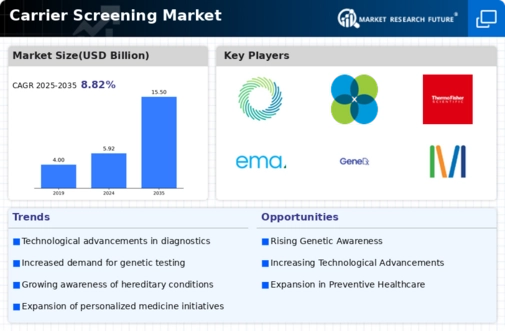Market Growth Projections
Government Initiatives and Support
Government initiatives and support for genetic testing programs are likely to bolster the Global Carrier Screening Market Industry. Many countries are implementing policies that encourage the integration of carrier screening into routine healthcare practices. These initiatives often include funding for research, public awareness campaigns, and the establishment of guidelines for genetic testing. Such support not only enhances accessibility to carrier screening but also fosters collaboration among healthcare providers, researchers, and policymakers. As a result, the market is expected to benefit from increased participation in screening programs, ultimately leading to improved health outcomes.
Rising Prevalence of Genetic Disorders
The rising prevalence of genetic disorders globally is a crucial factor influencing the Global Carrier Screening Market Industry. With an increasing number of individuals diagnosed with conditions such as cystic fibrosis, sickle cell disease, and Tay-Sachs disease, the demand for carrier screening is expected to grow. This trend is particularly pronounced in populations with a higher carrier frequency for specific genetic disorders. The market's expansion is further supported by healthcare policies that promote genetic testing as a preventive measure. By 2035, the market is projected to reach 15.5 USD Billion, reflecting the urgent need for effective screening solutions.
Increasing Awareness of Genetic Disorders
The growing awareness of genetic disorders among the global population appears to be a significant driver of the Global Carrier Screening Market Industry. As individuals become more informed about the implications of genetic conditions, the demand for carrier screening tests rises. This trend is particularly evident in regions with high incidences of hereditary diseases, where educational initiatives and public health campaigns are prevalent. The market is projected to reach 5.92 USD Billion in 2024, reflecting an increasing recognition of the importance of early detection and prevention strategies in managing genetic disorders.
Technological Advancements in Screening Methods
Technological advancements in genetic testing methodologies are likely to propel the Global Carrier Screening Market Industry forward. Innovations such as next-generation sequencing (NGS) and improved bioinformatics tools enhance the accuracy and efficiency of carrier screening tests. These advancements facilitate the identification of a broader range of genetic mutations, thereby increasing the utility of screening programs. As a result, healthcare providers are more inclined to recommend these tests, contributing to market growth. The anticipated CAGR of 9.12% from 2025 to 2035 underscores the potential for continued expansion driven by these technological improvements.
Integration of Carrier Screening in Prenatal Care
The integration of carrier screening into prenatal care is emerging as a vital driver of the Global Carrier Screening Market Industry. Healthcare providers increasingly recommend carrier screening for prospective parents as part of comprehensive prenatal assessments. This practice allows for informed reproductive choices and better management of potential genetic risks. The growing acceptance of carrier screening in prenatal settings is indicative of a broader trend towards personalized medicine. As awareness of the benefits of early detection continues to spread, the market is poised for substantial growth, aligning with the overall trajectory of the healthcare landscape.














Leave a Comment